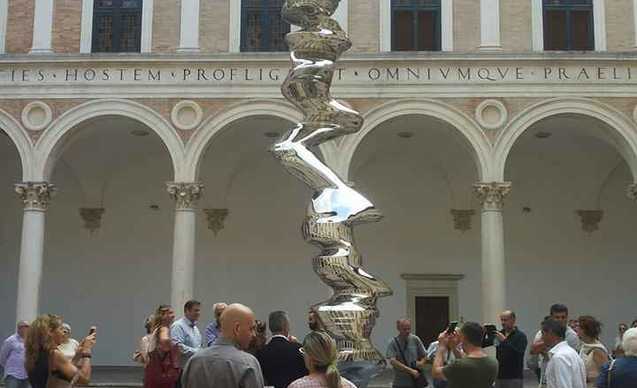Tony Cragg
Tony Cragg Elliptical Column Palazzo Ducale Urbino
In the center of the courtyard of honor of the Ducal Palace of Urbino, built by the Dalmatian architect Luciano Laurana between 1466 and 1472 by the will of Duke Federico da Montefeltro on July 22 is exposed, by Ludovico Pratesi, Elliptical Column, the column made of steel by the British artist Tony Cragg, considered one of the greatest living sculptors. A winding work, reminiscent of the tortile columns of the Canopy of San Pietro by Gian Lorenzo Bernini, which reflects the symmetrical and rigorous lines of the Renaissance court. A strong visual contrast of geometries, shapes and colors, which creates an interesting dialogue between the measure of the Renaissance, based on the theories of Leon Battista Alberti, of which Laurana had been a student in Mantua, and the twists of sculpture, which is imposed as vital and dynamic element on the surrounding environment. The work, with an irregular pattern, reflects on the mirroring surface the architecture of the building, creating an interesting relationship between work and space, past and present, harmony and movement.
The work
Elliptical Column is a work created in 2012 by Tony Cragg, exhibited for the first time in the exhibition Tony Cragg at Exibition Road in London (25/8 / -25 / 11/2012) and inspired by the biomorphism that characterizes the last cycles of works of the artist, Early Forms and Rational Beings, to which Elliptical Columnn belongs.
The strength of Elliptical Column is its ability to interact with the surrounding environment: urban, architectural or natural.
"There is the idea that the sculpture is static, or maybe even dead, but I feel the exact opposite. I am not a religious person - I am an absolute materialist. For me, the material is exciting and ultimately sublime. When I create a sculpture, I go in search of a spirituality or an ethics of the material. I want the material to have a dynamic, to push and move and grow "explains Cragg, who cites Medardo Rosso as the father of his approach to the use of materials in sculpture.
Tony Cragg has a strong relationship with our country, where he has exhibited several times (Venice Biennale 1988, Macro, Rome, 2003, Pescheria, Pesaro, 2006, Milan, Stelline Foundation, 2007, Ca 'Pesaro, Venice, 2010; Milan 2015). His sculptures have already been related to classical Italian monuments: in 2007 in the courtyard of the Stelline Foundation in Milan (on the occasion of the exhibition Material Toughts, curated by Ludovico Pratesi) and in 2015 on the roof of the Duomo in Milan, to confirm the presence of a strong classical component in his work, capable of combining academic rigor and contemporaneity, through daring plastic compositions that enhance the material component of his work.
Born in Liverpool (UK) in 1949, Anthony Cragg has lived and worked in Wupppertal, Germany since 1977. He has exhibited at the Hermitage in St. Petersburg (2016), at the Benaki museum in Athens (2015), at the Cafa Museum in Beijing ( 2012), at the Louvre in Paris (2011) at the Tate Gallery in Liverpool (2000) at the Reina Sofia in Madrid (1995) and at the Tate Gallery in London (1988). He represented Great Britain at the 43rd Venice Biennale (1988) and the same year won the Turner Prize. He won the Imperial Sculpture Award in Tokyo in 2007. His works are in the collections of the main international contemporary art museums.
